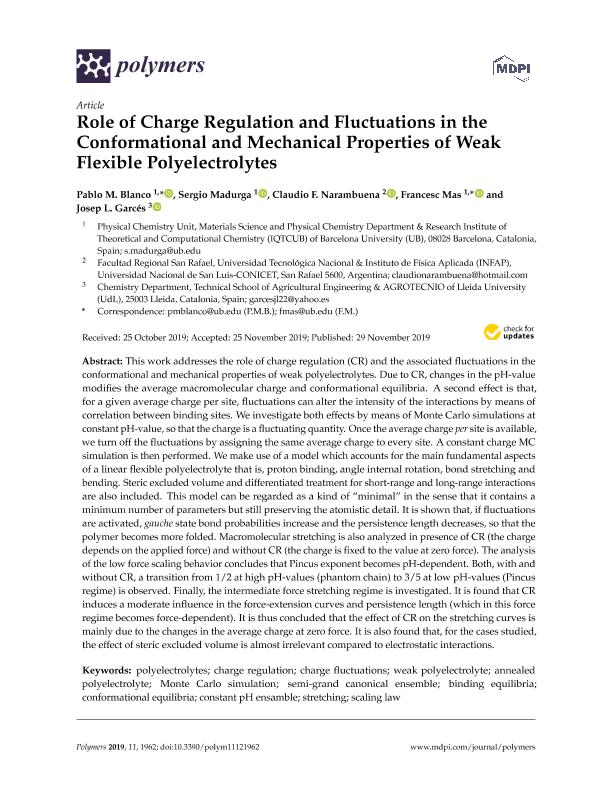Mostrar el registro sencillo del ítem
dc.contributor.author
Blanco, Pablo M.
dc.contributor.author
Madurga Díez, Sergio

dc.contributor.author
Narambuena, Claudio Fabian

dc.contributor.author
Mas Pujadas, Francesc

dc.contributor.author
Garcés, Josep L.
dc.date.available
2023-01-03T02:07:15Z
dc.date.issued
2019-11
dc.identifier.citation
Blanco, Pablo M.; Madurga Díez, Sergio; Narambuena, Claudio Fabian; Mas Pujadas, Francesc; Garcés, Josep L.; Role of Charge Regulation and Fluctuations in the Conformational and Mechanical Properties of Weak Flexible Polyelectrolytes; Multidisciplinary Digital Publishing Institute; Polymers; 11; 12; 11-2019
dc.identifier.uri
http://hdl.handle.net/11336/183029
dc.description.abstract
This work addresses the role of charge regulation (CR) and the associated fluctuations in the conformational and mechanical properties of weak polyelectrolytes. Due to CR, changes in the pH-value modifies the average macromolecular charge and conformational equilibria. A second effect is that, for a given average charge per site, fluctuations can alter the intensity of the interactions by means of correlation between binding sites. We investigate both effects by means of Monte Carlo simulations at constant pH-value, so that the charge is a fluctuating quantity. Once the average charge per site is available, we turn off the fluctuations by assigning the same average charge to every site. A constant charge MC simulation is then performed. We make use of a model which accounts for the main fundamental aspects of a linear flexible polyelectrolyte that is, proton binding, angle internal rotation, bond stretching and bending. Steric excluded volume and differentiated treatment for short-range and long-range interactions are also included. This model can be regarded as a kind of "minimal" in the sense that it contains a minimum number of parameters but still preserving the atomistic detail. It is shown that, if fluctuations are activated, gauche state bond probabilities increase and the persistence length decreases, so that the polymer becomes more folded. Macromolecular stretching is also analyzed in presence of CR (the charge depends on the applied force) and without CR (the charge is fixed to the value at zero force). The analysis of the low force scaling behavior concludes that Pincus exponent becomes pH-dependent. Both, with and without CR, a transition from 1/2 at high pH-values (phantom chain) to 3/5 at low pH-values (Pincus regime) is observed. Finally, the intermediate force stretching regime is investigated. It is found that CR induces a moderate influence in the force-extension curves and persistence length (which in this force regime becomes force-dependent). It is thus concluded that the effect of CR on the stretching curves is mainly due to the changes in the average charge at zero force. It is also found that, for the cases studied, the effect of steric excluded volume is almost irrelevant compared to electrostatic interactions.
dc.format
application/pdf
dc.language.iso
eng
dc.publisher
Multidisciplinary Digital Publishing Institute
dc.rights
info:eu-repo/semantics/openAccess
dc.rights.uri
https://creativecommons.org/licenses/by-nc-sa/2.5/ar/
dc.subject
ANNEALED POLYELECTROLYTE
dc.subject
BINDING EQUILIBRIA
dc.subject
CHARGE FLUCTUATIONS
dc.subject
CHARGE REGULATION
dc.subject
CONFORMATIONAL EQUILIBRIA
dc.subject
CONSTANT PH ENSAMBLE
dc.subject
MONTE CARLO SIMULATION
dc.subject
POLYELECTROLYTES
dc.subject
SCALING LAW
dc.subject
SEMI-GRAND CANONICAL ENSEMBLE
dc.subject
STRETCHING
dc.subject
WEAK POLYELECTROLYTE
dc.subject.classification
Otras Ciencias Físicas

dc.subject.classification
Ciencias Físicas

dc.subject.classification
CIENCIAS NATURALES Y EXACTAS

dc.title
Role of Charge Regulation and Fluctuations in the Conformational and Mechanical Properties of Weak Flexible Polyelectrolytes
dc.type
info:eu-repo/semantics/article
dc.type
info:ar-repo/semantics/artículo
dc.type
info:eu-repo/semantics/publishedVersion
dc.date.updated
2022-10-26T10:47:11Z
dc.identifier.eissn
2073-4360
dc.journal.volume
11
dc.journal.number
12
dc.journal.pais
Suiza

dc.journal.ciudad
Basel
dc.description.fil
Fil: Blanco, Pablo M.. Universidad de Barcelona. Facultad de Quimica. Instituto de Quimica Teorica y Computacional.; España
dc.description.fil
Fil: Madurga Díez, Sergio. Universidad de Barcelona. Facultad de Quimica. Instituto de Quimica Teorica y Computacional.; España
dc.description.fil
Fil: Narambuena, Claudio Fabian. Universidad Tecnologica Nacional. Facultad Regional San Rafael; Argentina. Consejo Nacional de Investigaciones Cientificas y Tecnicas. Centro Cientifico Tecnologico Conicet - San Luis. Instituto de Fisica Aplicada "dr. Jorge Andres Zgrablich". Grupo Vinculado Bionanotecnologia y Sistemas Complejos | Universidad Nacional de San Luis. Facultad de Cs.fisico Matematicas y Naturales. Instituto de Fisica Aplicada "dr. Jorge Andres Zgrablich". Grupo Vinculado Bionanotecnologia y Sistemas Complejos. - Universidad Tecnologica Nacional. Facultad Reg.san Rafael. Grupo Vinculado Bionanotecnologia y Sistemas Complejos.; Argentina
dc.description.fil
Fil: Mas Pujadas, Francesc. Universidad de Barcelona. Facultad de Quimica. Instituto de Quimica Teorica y Computacional.; España
dc.description.fil
Fil: Garcés, Josep L.. Lleida University; España
dc.journal.title
Polymers
dc.relation.alternativeid
info:eu-repo/semantics/altIdentifier/url/https://www.mdpi.com/2073-4360/11/12/1962
dc.relation.alternativeid
info:eu-repo/semantics/altIdentifier/doi/http://dx.doi.org/10.3390/polym11121962
Archivos asociados
